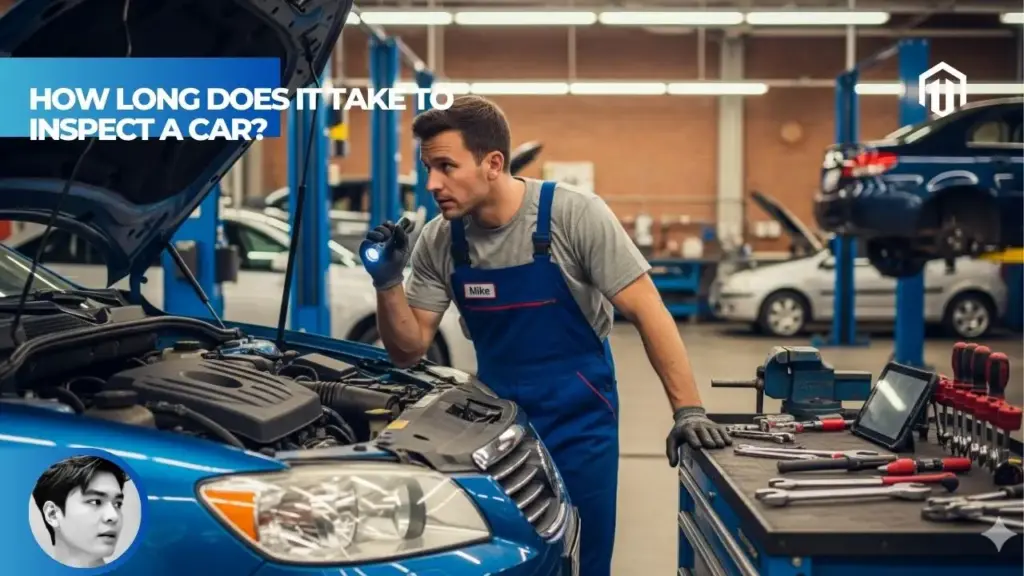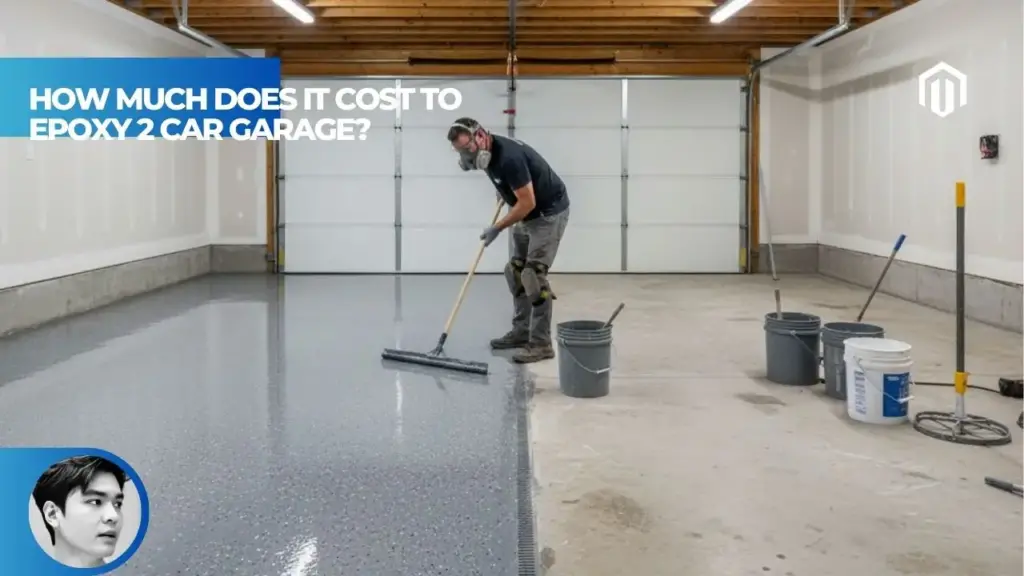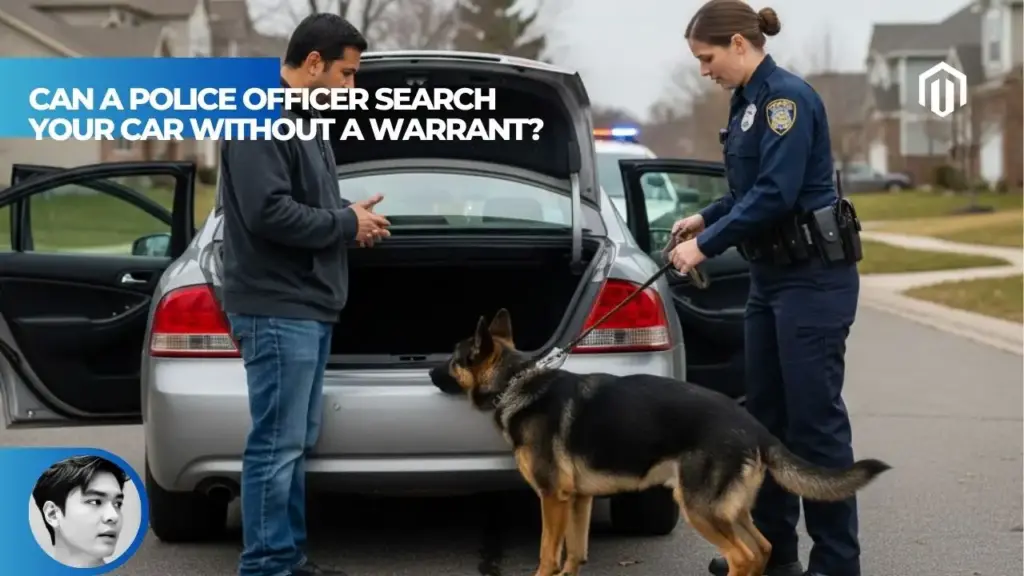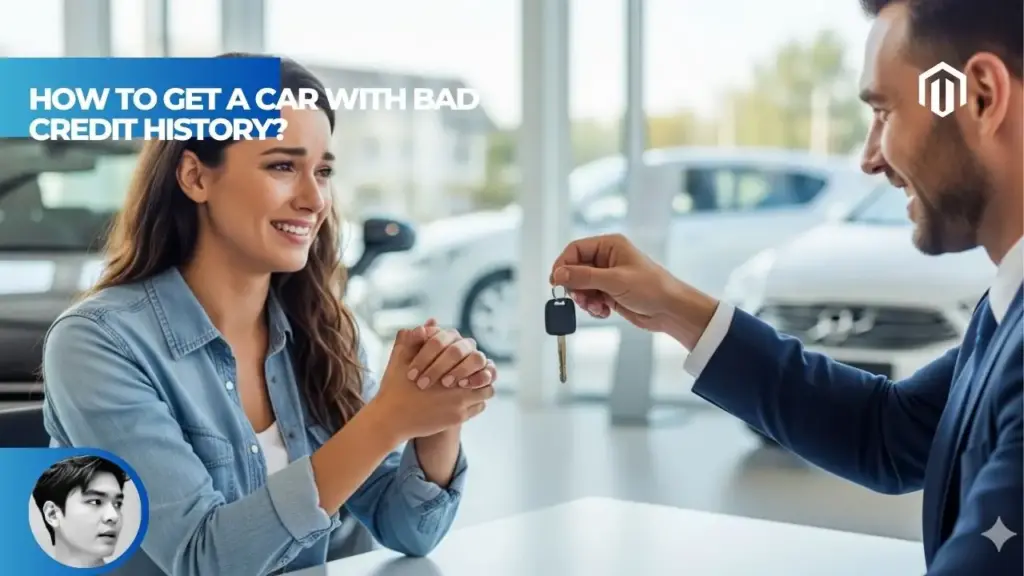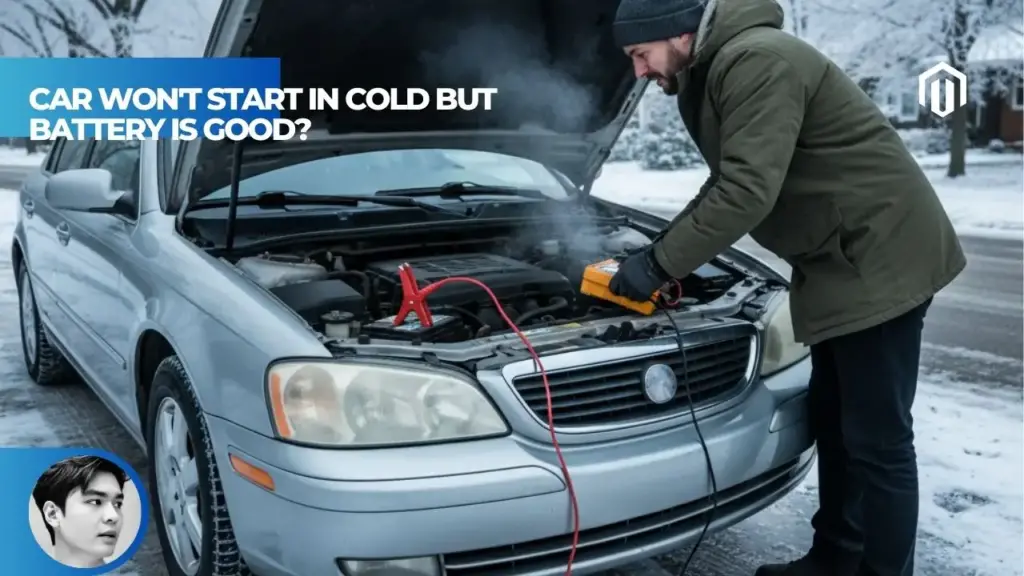You may also like:
- 【Explained】How Long Does It Take to Buy a Car? A Step-by-Step Timeline
- 【Explained】How Long Does It Take to Replace a Car Battery? (A Full Breakdown)
- 【Explained】How Long Does It Take to Align a Car? (The 30-Minute to 1-Hour Guide)
- 【Explained】What Happens When Your Car Is Totaled But Still Drivable?
- 【Explained】How Long Does It Take a Car to Cool Down? (The 30-Minute to 3-Hour Guide)
A standard car inspection typically takes 30-60 minutes for basic safety checks, though comprehensive pre-purchase inspections can require 1-2 hours or more. The actual duration varies significantly based on inspection type, vehicle condition, location, and whether issues are discovered during the process[1].
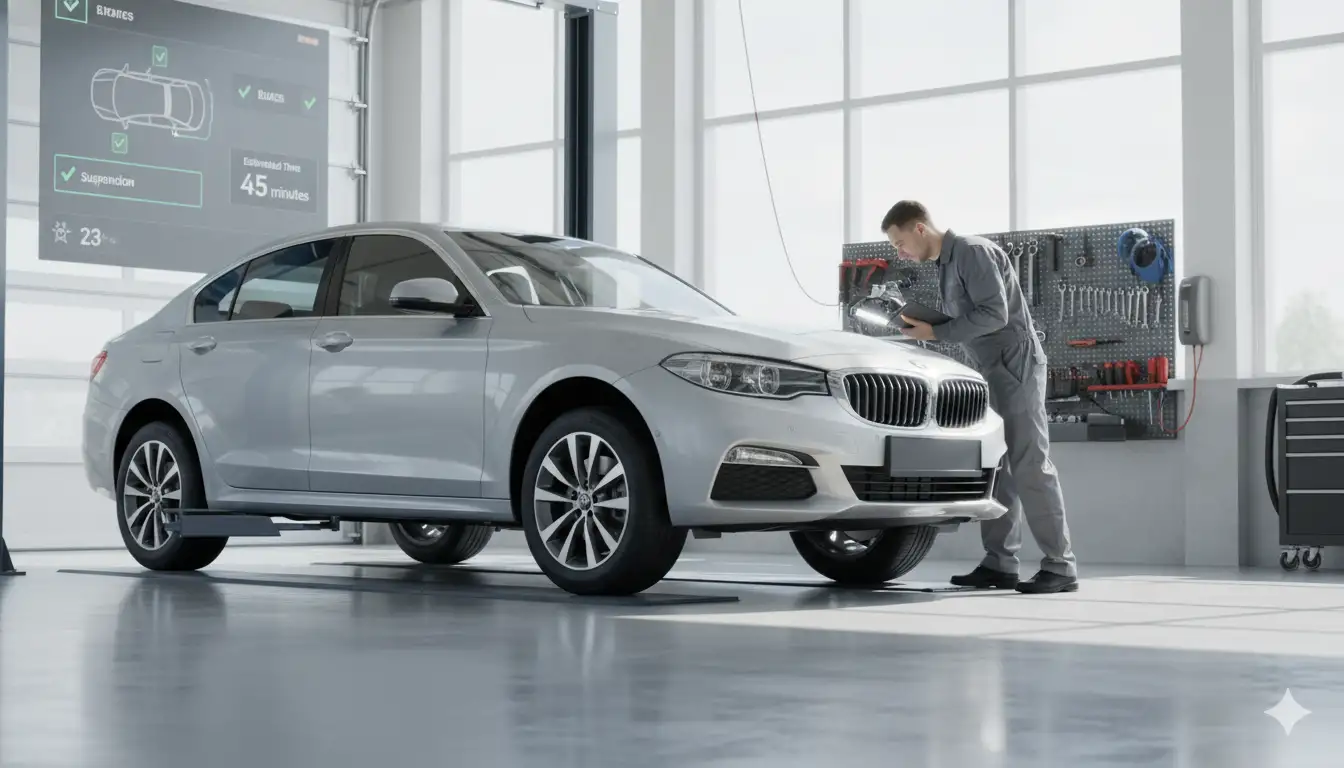
Vehicle Inspection Time Overview
Understanding how long a car inspection takes helps you plan your day effectively and avoid frustration at inspection stations. Whether you’re getting a routine state inspection or a detailed pre-purchase check, knowing what to expect saves valuable time.
Time for Car Inspection Standards
Standard vehicle inspections follow established protocols that determine baseline timeframes. According to industry data, routine safety inspections average 45 minutes nationwide, with variations based on state requirements and facility efficiency[1]. The inspection process includes systematic checks of critical safety components, each requiring specific time allocations.
Most inspection stations operate on appointment schedules designed around these standard timeframes. Walk-in customers typically experience longer wait times, especially during peak periods near registration deadlines. Autvex automotive experts recommend scheduling appointments at least one week in advance to secure preferred time slots.
State regulations mandate minimum inspection durations to ensure thoroughness. Texas, for example, requires technicians to spend adequate time examining each component before issuing certification, though starting January 2025, the state will eliminate safety inspections for non-commercial vehicles while maintaining emissions testing requirements[2].
How Long Does Safety Check Take
Safety inspections focus on vehicle components critical for road safety, typically completing within 30-45 minutes for vehicles in good condition[3]. This timeframe covers essential systems including brakes, lights, tires, steering, and windshield condition.
| Component Category | Time Required | Items Checked |
|---|---|---|
| Lighting System | 5-7 minutes | Headlights, brake lights, turn signals, hazards |
| Brake System | 8-10 minutes | Pads, rotors, fluid, parking brake |
| Tires & Wheels | 5-8 minutes | Tread depth, pressure, alignment wear |
| Steering/Suspension | 7-10 minutes | Play, leaks, component wear |
| Glass & Mirrors | 3-5 minutes | Cracks, visibility, adjustment |
Newer vehicles generally pass through safety checks faster due to less wear and modern diagnostic capabilities. Vehicles manufactured after 2020 often feature onboard diagnostics that expedite certain inspection elements, reducing overall time by 15-20%[4].
Inspection Checklist and Duration
A comprehensive inspection checklist ensures nothing gets overlooked while maintaining efficient timeframes. Professional inspectors follow standardized procedures that balance thoroughness with practical time constraints.
Standard inspection checklist timing breakdown:
- Documentation verification: 3-5 minutes
- Exterior visual inspection: 8-10 minutes
- Under-hood checks: 10-12 minutes
- Interior safety features: 5-7 minutes
- Undercarriage examination: 8-10 minutes
- Road test (if required): 5-10 minutes
- Final paperwork: 3-5 minutes
Digital inspection systems increasingly streamline this process. AI-powered inspection technology can reduce standard inspection times by up to 50%, with some systems completing comprehensive vehicle scans in just 15 minutes[5].
Types of Inspections and Their Duration
Different inspection types serve varying purposes, each requiring specific time investments based on depth and complexity.
State Inspection Duration
State-mandated inspections vary significantly across the United States, with 14 states requiring periodic safety inspections and 17 counties in Texas maintaining emissions testing requirements[2]. These variations directly impact inspection duration and complexity.
Safety Inspection Duration
Traditional safety inspections examine mechanical components essential for vehicle operation and occupant protection. Most states allocate 30-60 minutes for standard safety inspections, though older vehicles may require additional time for thorough evaluation[3].
States with comprehensive safety programs like Pennsylvania and New York require more extensive checks, potentially extending inspection times to 60-75 minutes. Conversely, states phasing out safety inspections, like Texas in 2025, shift focus entirely to emissions testing, significantly reducing total inspection time.
The elimination of safety inspections in certain jurisdictions reflects evolving perspectives on vehicle safety and maintenance responsibility. However, regular maintenance remains crucial regardless of state requirements.
Emissions Test Time
Emissions testing focuses specifically on pollution control systems, typically completing in 15-30 minutes when conducted separately[6]. Modern OBD-II equipped vehicles (1996 and newer) undergo computerized testing that quickly analyzes emission control system performance.
Combined safety and emissions inspections naturally take longer, averaging 45-60 minutes total. Some facilities offer express emissions-only testing lanes for vehicles not requiring safety inspections, reducing wait times significantly during peak periods.
Pre-Purchase Inspection Length
Pre-purchase inspections provide comprehensive vehicle evaluations for prospective buyers, requiring substantially more time than routine inspections. These detailed assessments typically span 1.5-2 hours, with some extending to 3 hours for luxury or vintage vehicles[7].
Pre-purchase inspection time allocation:
- Initial documentation review: 10 minutes
- Comprehensive exterior inspection: 20-25 minutes
- Detailed interior assessment: 15-20 minutes
- Mechanical systems evaluation: 30-40 minutes
- Test drive and performance check: 15-20 minutes
- Report preparation: 15-20 minutes
Professional inspection services like those recommended by Autvex often provide detailed photographic documentation, adding approximately 15-20 minutes to the total inspection time but offering invaluable visual evidence of vehicle condition.
Used Car Inspection Time
Used car inspections require particular attention to wear patterns and potential hidden issues. Inspectors spend additional time examining components prone to deterioration, including suspension bushings, CV joints, and exhaust systems[7].
The age and mileage of used vehicles directly correlate with inspection duration. Vehicles over 10 years old or with 100,000+ miles typically require 20-30% more time than newer models due to increased likelihood of wear-related issues. High-mileage vehicles demand extra scrutiny of critical components.
Vehicle Service Time Comparison
Understanding how inspection times compare to regular service appointments helps with scheduling decisions. While basic inspections take 30-60 minutes, combining inspections with routine maintenance can improve efficiency.
| Service Type | Typical Duration | Can Combine with Inspection |
|---|---|---|
| Oil Change | 15-30 minutes | Yes – adds 10 minutes |
| Tire Rotation | 15-20 minutes | Yes – included in inspection |
| Brake Service | 45-90 minutes | Partial – extends inspection |
| Tune-up | 60-120 minutes | No – separate appointment |
Many facilities offer package deals combining inspections with basic maintenance, potentially saving both time and money while ensuring comprehensive vehicle care.
Factors That Influence Inspection Duration
Multiple variables affect how long your vehicle inspection takes, from the car itself to the facility’s operational efficiency.
Vehicle Type Impact (Sedan, SUV, Truck)
Vehicle size and complexity significantly influence inspection duration. Larger vehicles require more time for complete examination, with trucks and SUVs typically taking 10-20% longer than standard sedans[8].
Average inspection times by vehicle type:
- Compact cars: 25-35 minutes
- Mid-size sedans: 30-45 minutes
- SUVs: 40-55 minutes
- Pickup trucks: 45-60 minutes
- Commercial vehicles: 60-90 minutes
Specialty vehicles like luxury sports cars or high-end SUVs often feature complex systems requiring specialized knowledge, potentially extending inspection times beyond standard estimates.
Vehicle Condition Affecting Inspection Time
Well-maintained vehicles breeze through inspections faster than neglected ones. A vehicle with obvious issues like worn tires or non-functional lights requires additional documentation and often triggers more thorough examination of related systems[8].
Regular maintenance dramatically reduces inspection time. Vehicles with complete service records and recent maintenance typically complete inspections 25-30% faster than those with unknown maintenance history. Pre-inspection preparation, such as ensuring all lights work and tires are properly inflated, prevents delays.
Visible damage or modifications also extend inspection duration. Custom exhaust systems, lifted suspensions, or aftermarket lighting require extra verification to ensure compliance with state regulations.
Failing Inspection Reasons and Additional Time
When vehicles fail initial inspection, the process extends significantly. Common failure reasons include worn brake pads, inadequate tire tread, and burned-out lights—issues that require repair before re-inspection[9].
Top inspection failure causes and time impact:
- Brake system issues: Adds 1-2 hours for repair
- Lighting problems: Adds 15-30 minutes per bulb
- Tire replacement: Adds 30-45 minutes per tire
- Windshield cracks: May require 1-2 day delay for replacement
- Emissions failures: Often requires diagnostic time plus repairs
Failed inspections typically include a grace period for repairs, varying by state from 15-30 days. Re-inspections after repairs usually take 15-20 minutes, focusing only on previously failed components.
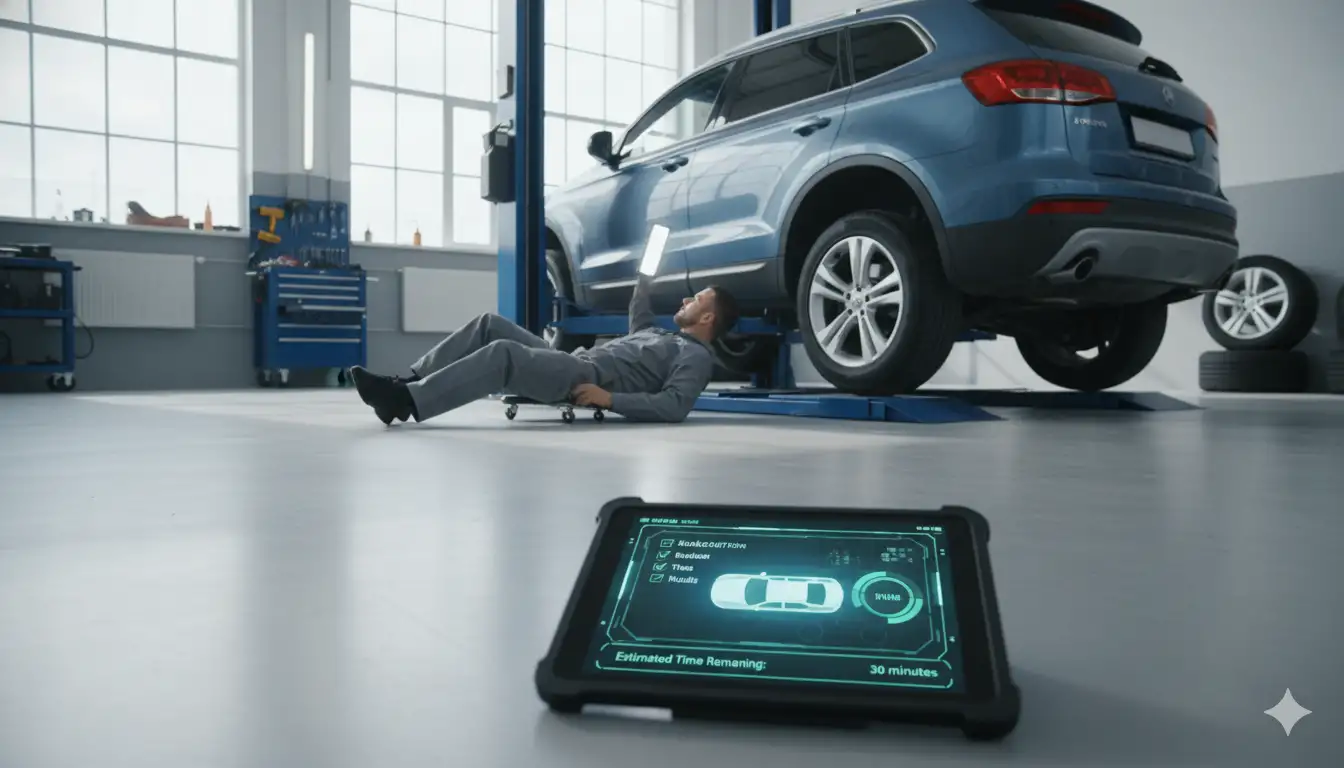
Inspection Location and Process Variables
Where you get your inspection significantly impacts both wait time and service duration.
Inspection Location (Shop, Mobile, Dealership)
Different inspection venues offer varying advantages in terms of speed and convenience. Dedicated inspection stations typically provide the fastest service, averaging 30-40 minutes for standard inspections[10].
Dealerships often take longer, averaging 45-75 minutes, but provide comprehensive digital records and may identify recall issues during inspection. Their higher labor rates reflect specialized expertise, particularly valuable for luxury vehicles.
Mobile inspection services represent a growing trend, bringing convenience directly to customers. While mobile inspections may take slightly longer—typically 45-60 minutes—they eliminate travel time and waiting room delays.
Appointment vs. Walk-in Timing
Scheduling appointments virtually guarantees faster service compared to walk-in visits. Appointment holders typically wait 0-15 minutes before inspection begins, while walk-ins may wait 30-90 minutes during busy periods[10].
Peak inspection periods to avoid:
- Last week of each month
- Days before holiday weekends
- Monday mornings and Friday afternoons
- Lunch hours (11:30 AM – 1:30 PM)
- End of registration grace periods
Early morning appointments (8:00-9:00 AM) often provide the fastest service, as technicians are fresh and facilities aren’t yet crowded.
Waiting Time for Inspection
Beyond the actual inspection duration, total time investment includes waiting periods. Factors affecting wait times include facility capacity, staffing levels, and seasonal demand fluctuations[10].
Smart scheduling significantly reduces waiting. Many modern facilities offer online appointment systems showing real-time availability, text notifications when your vehicle is ready, and even live queue position updates.
Repair Shop Wait Time
General repair shops conducting inspections alongside regular services often have longer wait times than dedicated inspection stations. These facilities typically schedule inspections between larger repair jobs, potentially causing delays[11].
However, repair shops offer advantages when issues are discovered during inspection. Immediate repair capability can save time overall, eliminating the need to visit multiple locations. Many shops offer “while-you-wait” service for minor repairs discovered during inspection.
Components Checked and Time Requirements
Understanding individual component inspection times helps explain overall duration and identify potential delays.
Brakes Check Time
Brake system inspection represents one of the most time-intensive components, requiring 8-10 minutes for thorough evaluation[3]. Inspectors examine pad thickness, rotor condition, brake fluid level and color, and parking brake operation.
Modern brake wear indicators simplify visual inspection, but older vehicles may require wheel removal for accurate assessment. Shops with brake measurement tools can quickly determine remaining pad life, providing valuable maintenance planning information beyond pass/fail status.
Tires Check Time
Tire inspection encompasses tread depth measurement, pressure verification, and wear pattern analysis, typically completing in 5-8 minutes for all four tires[3]. Digital tread depth gauges accelerate this process while providing precise measurements.
Uneven tire wear often indicates alignment or suspension issues, prompting additional inspection time. The legal minimum tread depth of 2/32 inch serves as the pass/fail threshold, though safety experts recommend replacement at 4/32 inch for optimal wet weather performance.
Lights and Signals Check
Lighting system checks proceed quickly when all components function properly, requiring just 5-7 minutes[3]. However, a single malfunctioning bulb can add 15-30 minutes if replacement is needed.
Comprehensive lighting inspection includes:
- Headlights (low and high beam)
- Brake lights and third brake light
- Turn signals (all four corners)
- Hazard flashers
- License plate lights
- Side markers and reflectors
LED lighting systems generally pass inspection more reliably than traditional bulbs, though some aftermarket LED conversions may fail due to improper beam patterns or excessive brightness.
Steering and Suspension Check
Steering and suspension inspection requires 7-10 minutes for standard evaluation, examining components for excessive play, leaks, and wear[3]. This critical safety check often reveals issues in older vehicles, particularly those driven on rough roads.
Technicians check for steering wheel play, power steering fluid leaks, worn ball joints, and damaged CV boots. Any discovered issues typically trigger more detailed inspection, potentially adding 10-15 minutes to the process.
Exhaust Inspection Duration
Exhaust system inspection combines visual examination with emissions testing where required, taking 5-10 minutes for complete evaluation[6]. Inspectors check for leaks, excessive rust, and proper mounting while ensuring the catalytic converter remains intact.
Modified exhaust systems require additional scrutiny to verify compliance with noise regulations. Some states measure actual decibel levels, adding 5-10 minutes to the inspection process for vehicles with aftermarket exhausts.
Modern Inspection Methods
Technology transforms traditional inspection processes, offering faster, more accurate assessments.
Manual vs. AI Inspection
Artificial intelligence revolutionizes vehicle inspections, potentially reducing inspection times by 50-70% compared to traditional manual methods[5]. AI-powered systems use computer vision and machine learning to identify issues in seconds that might take human inspectors minutes to detect.
| Inspection Method | Average Time | Accuracy Rate | Cost |
|---|---|---|---|
| Traditional Manual | 45-60 minutes | 85-90% | $25-50 |
| Hybrid (Manual + Digital) | 30-40 minutes | 90-95% | $35-60 |
| Full AI Inspection | 15-20 minutes | 95-98% | $40-75 |
Companies like UVeye and Tchek lead this technological revolution, offering “MRI for cars” that captures thousands of images in seconds, analyzing them for defects instantaneously[5]. These systems excel at identifying undercarriage damage, frame issues, and even tire wear patterns often missed during manual inspections.
Mechanic Efficiency Factors
Individual technician efficiency significantly impacts inspection duration. Experienced inspectors complete thorough evaluations 20-30% faster than novices while maintaining higher accuracy rates[11].
Factors affecting mechanic efficiency:
- Years of experience (5+ years optimal)
- Familiarity with specific vehicle makes/models
- Access to proper tools and equipment
- Workload and fatigue levels
- Continuous training on new technologies
Shops monitoring technician efficiency report that top performers complete 8-10 inspections daily, while average technicians manage 5-7. Autvex-certified facilities emphasize ongoing training to maintain high efficiency standards.
Documentation Time
Paperwork and documentation consume 5-10 minutes of total inspection time, though digital systems increasingly streamline this process[12]. Electronic inspection reporting eliminates handwritten forms, reducing errors and speeding completion.
Modern documentation systems automatically populate vehicle information from VIN scanning, generate detailed reports with photos, store results in cloud databases, and instantly email results to customers. This digitalization saves approximately 3-5 minutes per inspection while providing superior record-keeping.
Preparing for Car Inspection
Proper preparation significantly reduces inspection time and increases pass probability.
How to Prepare for Quick Inspection
Strategic preparation can reduce your inspection time by 15-20 minutes and prevent failure-related delays[8]. Start by addressing obvious issues that commonly cause failures.
Pre-inspection checklist:
- Test all lights and replace burned bulbs
- Check tire pressure and tread depth
- Ensure windshield wipers work properly
- Top off all fluids
- Remove excessive window tint if applicable
- Clear check engine lights if possible
- Gather required documentation
Clean vehicles inspect faster as technicians can easily access and evaluate components. Remove personal items from the vehicle, especially anything blocking access to the OBD-II port or spare tire.
Schedule inspections early in your registration period to allow time for any necessary repairs. Last-minute inspections create stress and limit options if issues arise.
What Happens If My Car Fails Inspection
Inspection failure doesn’t mean immediate driving prohibition in most states. You typically receive a detailed failure report listing specific issues and a 15-30 day grace period for repairs[9].
Post-failure process:
- Review failure report for specific issues
- Obtain repair estimates from qualified shops
- Complete necessary repairs
- Return for re-inspection (often free or reduced fee)
- Receive passing certificate upon compliance
Some states offer temporary permits allowing driving during repair periods. Re-inspections focus only on previously failed items, typically completing in 10-15 minutes. Consider using the initial failure as an opportunity for comprehensive maintenance, addressing both required and recommended repairs.
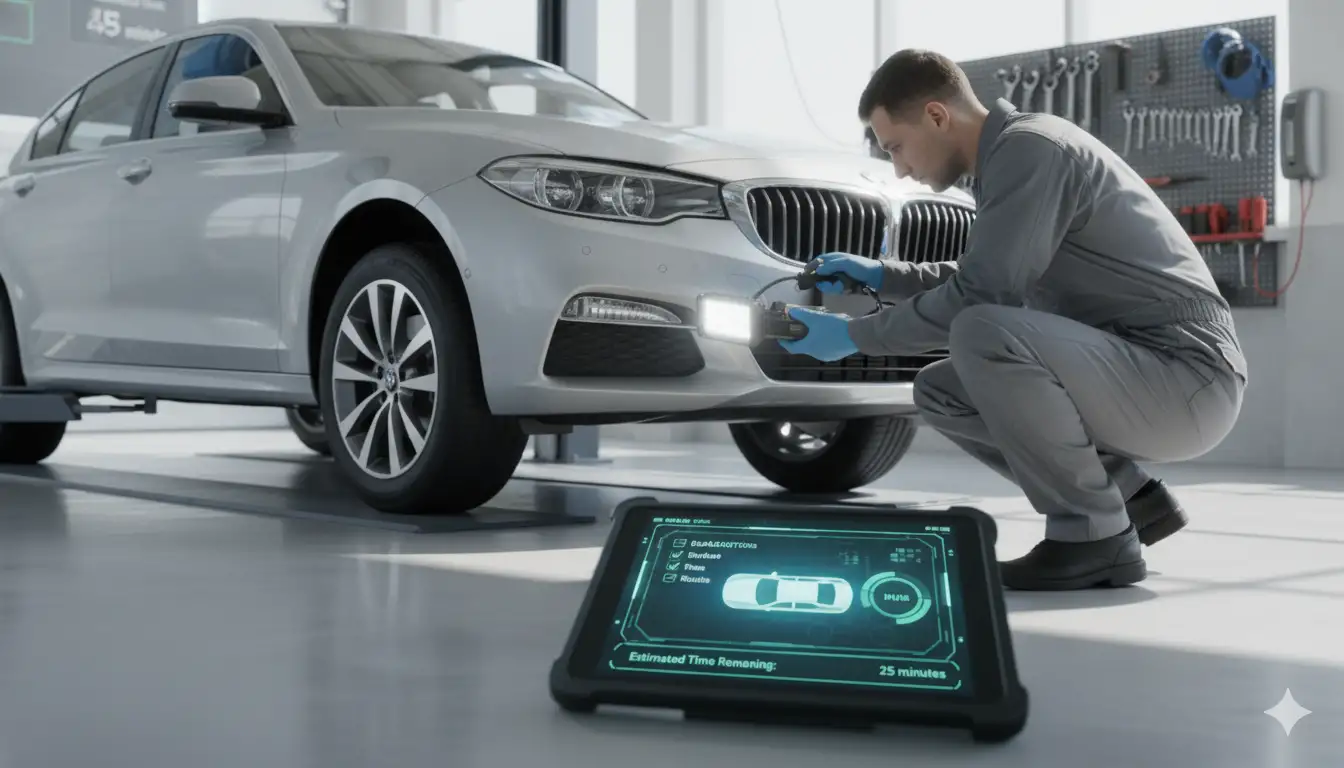
Key Takeaways
- Standard inspections take 30-60 minutes for basic safety checks
- Pre-purchase inspections require 1.5-2 hours for comprehensive evaluation
- Appointments reduce wait times by 45-75 minutes compared to walk-ins
- Vehicle type affects duration with trucks taking 20% longer than sedans
- AI technology can reduce inspection time by 50% while improving accuracy
- Failed inspections allow 15-30 days for repairs and re-inspection
- Proper preparation saves 15-20 minutes and prevents common failures
Next Steps
Schedule your inspection appointment in advance to minimize wait time, ensure your vehicle is properly maintained beforehand, and allocate 1-2 hours for the complete process including documentation. If your vehicle fails, budget additional time for repairs and re-inspection.
Immediate preparation steps:
- Check your state’s specific inspection requirements
- Test all vehicle lights and signals
- Schedule appointment 1-2 weeks in advance
- Address obvious issues before inspection
- Gather registration and insurance documents
For optimal results:
- Choose certified inspection facilities
- Consider combining with routine maintenance
- Keep inspection records for resale value
- Plan inspections during off-peak periods
- Use comprehensive inspection services for used car purchases
Understanding inspection timeframes and requirements ensures smooth, efficient service while maintaining vehicle safety and legal compliance.
Frequently Asked Questions
How long does a standard car inspection take?
A standard safety inspection typically takes 30-60 minutes, covering essential components like brakes, lights, tires, and emissions. The exact time depends on vehicle condition and inspection facility efficiency[1].
How long does a pre-purchase inspection take?
Pre-purchase inspections are comprehensive and take 1.5-2 hours, sometimes extending to 3 hours for thorough evaluations including test drives, undercarriage checks, and detailed mechanical assessments[7].
What factors can make a car inspection take longer?
Vehicle age, poor maintenance condition, discovered issues requiring additional testing, complex vehicle systems, busy inspection stations, and required repairs all extend inspection duration beyond standard timeframes[8].
What is the fastest way to get a car inspected?
Schedule an appointment rather than walk-in, maintain your vehicle properly beforehand, arrive with all required documentation, and choose dedicated inspection stations over general repair shops for fastest service[10].
How long does an emissions inspection take?
Emissions-only inspections are typically quick, taking 15-30 minutes when no other systems are checked. Combined with safety inspection, total time increases to 45-60 minutes[6].
Is an older car inspection longer than a new car inspection?
Yes, older vehicles often require 20-50% more inspection time due to potential wear issues, rust checks, and more thorough component examination compared to newer, well-maintained vehicles[8].
How long is the wait at most car inspection stations?
Wait times vary significantly: appointment holders typically wait 0-15 minutes, while walk-ins may wait 30-90 minutes depending on facility capacity and time of day[10].
How to prepare my car to ensure a quick inspection?
Check all lights work, ensure proper tire pressure, fix obvious issues beforehand, clean the vehicle for easier access, and bring all required documentation to expedite the process[8].
What happens if my car fails inspection?
You receive a detailed failure report, must complete necessary repairs, then return for re-inspection. Re-inspection timeframe varies by state, typically within 15-30 days[9].
References
- MyAirbags. (2025). How Long Does Car Inspection Take? Complete Guide. blog.myairbags.com/how-long-does-car-inspection-take
- Texas DMV. (2024). Texas vehicle inspection changes coming soon. www.txdmv.gov/sites/default/files/body-files/2024-09-09-Vehicle-Inspection-Changes.pdf
- Jesse Britts Automotive. (2024). How Long Does a Car Inspection Really Take. www.jessebrittsautomotive.com
- Toyota Creek. (2024). How Long Does a Car Inspection Typically Take. toyotacreek.com/how-long-does-a-car-inspection-typically-take/
- InspektLabs. (2025). The increasing adoption of AI-powered vehicle inspections. inspektlabs.com/blog/ai-adoption-in-vehicle-inspections/
- Texas First Auto. (2025). How Long Do Most Car Inspections Take. texasfirstautoinspections.com/how-long-do-most-car-inspections-take/
- ASAP Roadworthys. (2025). How Long Does A Pre Purchase Inspection Take. www.asaproadworthys.com.au/how-long-does-a-pre-purchase-inspection-take/
- UHM Cars. (2025). How Long Does a Car Inspection Take Average Times. uhmcars.com/blog/how-long-does-a-car-inspection-take/
- Insurify. (2024). Vehicle Inspection Requirements by State. insurify.com/car-insurance/vehicle/state-vehicle-inspection/
- SimplyFleet. (2025). How Long Should a Vehicle Inspection Really Take. www.simplyfleet.app/blog/how-long-should-a-vehicle-inspection-really-take
- PartsTeach. (2024). How to Speed Up Vehicle Inspection Times. partstech.com/resource/blog/how-to-speed-up-vehicle-inspection-times
- Car Studio AI. (2025). Ultimate Auto Inspection Guide for 2025. carstudio.ai/blog/ultimate-auto-inspection-guide-for-2025

I am a senior automotive analyst at Autvex. Expert vehicle evaluations, in-depth reviews, and objective analysis helping readers make informed automotive decisions with years of industry experience.

